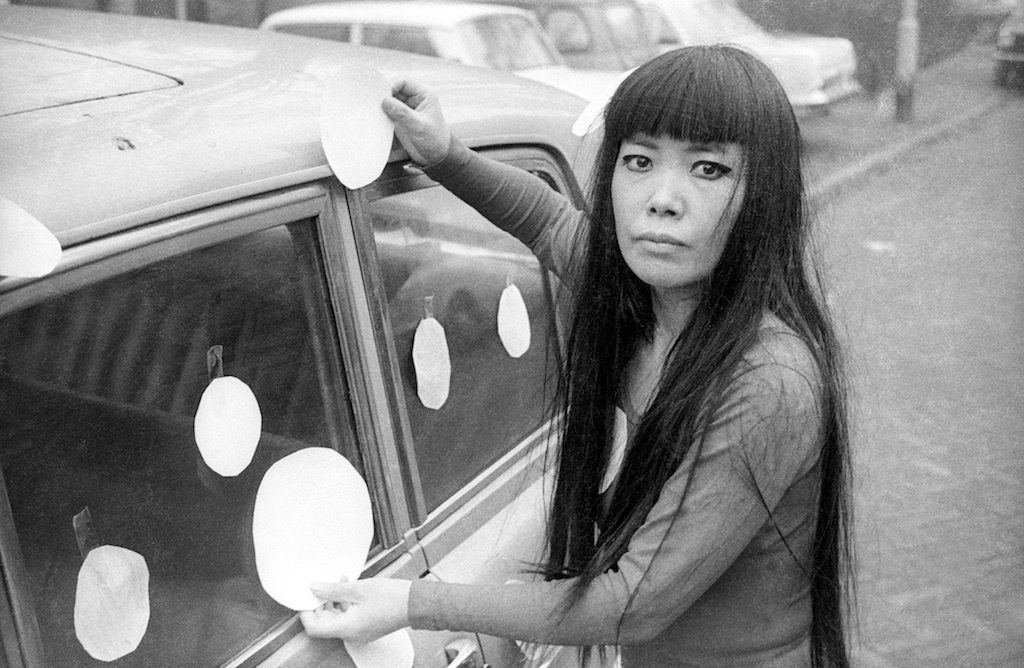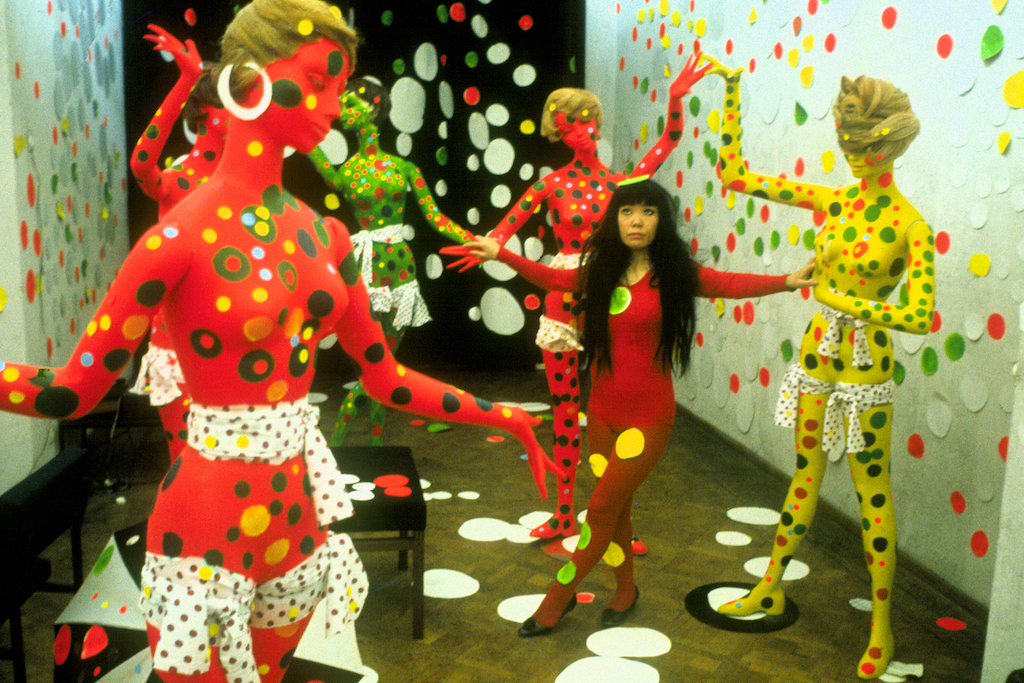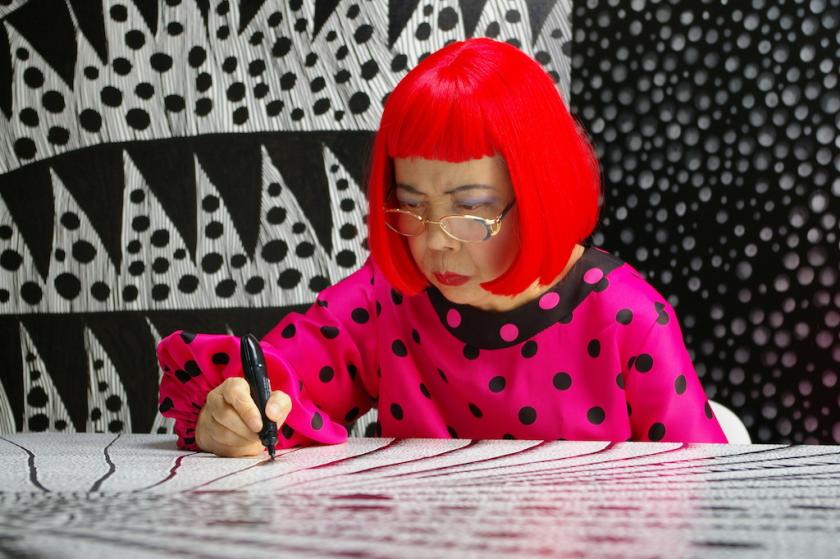Wearing a red dress covered in black polka dots and a bright red wig, Japanese artist Yayoi Kusama sits drawing, a look of intense concentration on her face. It takes her three days, she says, to finish one of these huge repeating patterns (main picture) and ideas pour out faster than she can realise them, even though she works all day, six days a week.
She must be the most prolific artist alive; she is also one of the most popular. People queue for hours to gain entry to her exhibitions and last year she opened her own five-storey gallery in Tokyo. The main draw are the infinity installations, mirrored environments which reflect everything inside them ad infinitum. At 89, Kusama is also the most expensive female artist alive. She began making bronze pumpkin sculptures in 1994; they now sell for $500,000 and can be seen in museums the world over. In 2014 an abstract painting of the kind she sold in 1962 to her artist friend Frank Stella for $75 fetched a record $7.1million.
Salvation lay in drawing and painting; she would overcome her fears by translating them into pictures
Heather Lenz’s film hardly touches on the phenomenon of Kusama’s worldwide success, though. Instead it focuses on the early years when Kusama was struggling to make her way in the New York art world and, before that, on the childhood that left an indelible mark on her.
Kusama was born in 1929 to a wealthy family in Matsumoto City, a provincial town in Nagano Prefecture. Her mother enlisted her daughter to spy on her philandering husband; nothing is made explicit, but it seems that the little girl caught him in flagrante and this instilled in her a horror of sex. The family business was growing flowers and seeds; Kusama would go to the fields and draw the flowers until, one day, she suddenly felt overwhelmed by the blooms – lost in space, obliterated by them. It was the first of many frightening hallucinations.
Salvation lay in drawing and painting; she would overcome her fears by translating them into pictures and, at the age of 10, decided to become an artist. But her mother, who wanted her to study etiquette and make a good marriage, would creep up behind her, grab the paintings and rip them to shreds.  Kusama exhibited a series of Miroesque abstracts in her home town, but received little response. If she was to achieve anything, it was clear that she would have to leave this conservative backwater and head for the bright lights. She wrote and asked the American painter Georgia O’Keeffe for advice and sent her some watercolours. O’Keeffe encouraged her to make the leap and in 1958, after burning 2,000 paintings in a ritual farewell, Kusama left Japan for New York with a few hundred dollars sewn into her kimono.
Kusama exhibited a series of Miroesque abstracts in her home town, but received little response. If she was to achieve anything, it was clear that she would have to leave this conservative backwater and head for the bright lights. She wrote and asked the American painter Georgia O’Keeffe for advice and sent her some watercolours. O’Keeffe encouraged her to make the leap and in 1958, after burning 2,000 paintings in a ritual farewell, Kusama left Japan for New York with a few hundred dollars sewn into her kimono.
Using interviews, archive photographs and footage, and the artist’s own testimony, Lenz gives a detailed account of Kusama’s time in New York. We see the net paintings inspired by the rippling surface of the Pacific Ocean as viewed from the air. The tiny cellular shapes endlessly repeat on canvases up to 30 feet long and we learn of Kusama’s tireless efforts to get them exhibited. In 1963 she began covering chairs, sofas and whole environments in penises made from stuffed canvas. When she appeared in a mixed show with Claes Oldenburg, according to Kusama, he pinched the soft sculpture idea to create the work that made him famous. And Andy Warhol’s cow wallpaper was inspired, she says, by her installation of a rowing boat festooned in penises adrift in a room with walls papered in pictures of the boat.
The theft of ideas is nothing new, but while her male colleagues forged ahead to become household names, Kusama continued to be treated as an eccentric outsider. Not surprisingly, this increasingly depressed her; she sought psychiatric help and was diagnosed with obsessive compulsive neurosis. At one point, she tried to commit suicide by jumping out of her studio window, but was saved by a bicycle.
In the late 1960s, she began staging peace happenings – painting polka dots on the naked bodies of dancing participants. With a keen eye for publicity, she staged one such event in the sculpture garden of the Museum of Modern Art. She created environments covered in polka dots (pictured below) and made a film of herself gradually disappearing in a blizzard of dots. News of these scandalous events finally reached her home town and she was struck off the list of alumni at her old school.  She didn’t get the recognition she deserved and her mental health continued to deteriorate, and in 1973 she returned to Japan. Three years later she checked herself into a mental hospital in Tokyo and has lived there ever since. This gives her the stability she needs to carry on; she maintains a studio a few yards from the hospital where she produces the work that, in recent years, has won her countless accolades. In 2006 alone she received a National Lifetime Achievement Award, the Order of the Rising Sun, and the Praemium Imperiale for painting.
She didn’t get the recognition she deserved and her mental health continued to deteriorate, and in 1973 she returned to Japan. Three years later she checked herself into a mental hospital in Tokyo and has lived there ever since. This gives her the stability she needs to carry on; she maintains a studio a few yards from the hospital where she produces the work that, in recent years, has won her countless accolades. In 2006 alone she received a National Lifetime Achievement Award, the Order of the Rising Sun, and the Praemium Imperiale for painting.
Lenz follows her changing fortunes as far as her selection to represent Japan at the Venice Biennale in 1993. This must have been a bitter sweet moment since, 27 years earlier, Kusama had gate-crashed the international art fair to install 1,500 shining spheres outside the Italian Pavilion in a desperate bid for recognition. The documentary more or less stops there, though, and so robs us of the glory days to come.
We need another film to tell us about the design and construction of her Tokyo gallery and the Yayoi Kusama Foundation she set up last year to oversee the vast range of her activities – from museum shows and installations to the production of giant bronze flowers and pumpkins, and collaborations with the fashion house Louis Vuitton and furniture makers such as Graf.
What a story and what an important moral lesson, though! Through sheer determination, the impoverished outsider who was desperate to be taken seriously has become not just a world-famous artist, but an institution with global reach.














